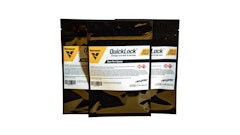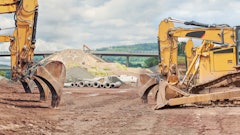
During the winter season, there is a greater need to evaluate your equipment’s lubrication to ensure you are receiving the highest level of performance from your fleet. The winter season affects much more than road conditions. Engine oil, coolant and diesel fuel can all be highly influenced by the change in weather, impacting the overall lifespan, efficiency and safety of your equipment.
If you wish to maximize your uptime with limited daylight, now is the time to evaluate and update your maintenance procedures to ensure a safe and smooth winter season.
Each year brings new products and requirements for how we should maintain our construction equipment properly, but a few standards stay tried and true. If this winter is anything like last, it is never too early to start preparing your fleet.
Engine Oil
When it comes to the colder months, your focus should turn to viscosity – the measure of a fluid’s resistance to flow. A fluid with low viscosity flows easier due to its molecular makeup, resulting in reduced friction when in motion.
A standard combination of numbers and letters found on most oil packaging represents the conditions in which the product is best used, for example, 15W-40. The “W” refers to “Winter,” and the numbers before the “W” refers to the performance at a cold start, while the numbers after the “W” indicates how the oil will flow once the engine is up and running at its operating temperature. It’s important to know that the higher the first number(s) is, the thicker the oil will be.
Diesel oils tend to “shear down” over time, meaning their viscosity range shrinks. As oil accumulates debris, it will start to thicken and become increasingly harder to pump, affecting your machine’s horsepower; oil that is nearing its end cannot provide the optimal engine protection needed during the uncertainty of the winter months. Checking your oil preseason is a critical step in the winterizing process.
For example, one may look at a fully-synthetic engine oil, a 5W-40 or 5W-30. In terms of the 5W-40 versus a 15W-40, the full synthetic 5W-40 is a thinner oil (due to the five versus the 15), so it will offer better cold weather start-up and overall protection. A full synthetic 5W-40 can be twice as expensive, or more, than its’ counterpart, 15W-40.
Greases
Like oil, it is essential to consider what grease you are using in the winter months. When it comes to greases, the industry uses a National Lubricating Grease Institute (NLGI) rating system, which includes 000, 00, 0, 1, 2, 3, 4, 5 and 6. The higher numbers correlate to the thickness of the grease and the speed at which it can flow through your machine, but even more critically, adhere to the component it is lubricating. Therefore, a 00 and 0 and up to a 1-rated grease will be favored for the winter months. From spring through fall, when temperatures can range from 45 to 110 degrees, it is important to transition to a thicker grease, such as a 2 NLGI grease. However, it is important when transitioning that you use greases with the same thickener, such as lithium, calcium, aluminum and sodium. When you want to transition from one thickener to another, purging the equipment is the best process to ensure minimal co-mixture of the different thickeners.
As a proactive measure, you can test grease via a state-of-the-art analysis lab to ensure there has not been any grease degradation or that other by-products have entered the greasing lines.
Cold Weather Startup
Another vital step when preparing your equipment for the winter is prioritizing “cold weather startup.” Essentially, by starting a piece of heavy equipment and letting it warm up before using it, you can prolong the longevity of the engine. At the time of typing this article, where I live In Montana, we have a few days with lows of -14 and -28 degrees and windchills of -38 and -54 degrees. However, you don’t have to live in Montana to establish a plan, as seen by the cold snap that hit Texas in 2021 and inevitably cost the state billions of dollars.
If you are operating your equipment during very cold winter months, using top-tier products, essentially full synthetic products, will offer the best protection for your equipment. With new diesel engine technology, you do not have to start and run your diesel engine for long periods. Allowing the machine to warm up before use also prevents extensive accusations of carbon accumulation in the engine, which the exhaust system may be unable to burn off very effectively.
Storing Your Equipment
For those who will be storing their equipment for the winter months, there is no need to change your current fluids; instead, invest your time in the exterior of your machine. There are a few key questions I’d recommend considering before storing your machinery.
Does your company have a shop to store equipment? How often can someone check the equipment that is stored outdoors? Do you have someone who can move your heavy equipment when needed? Do you have the resources to remove or prevent ice and frozen “gunk” from building up on the undercarriage of your equipment? If not, this can cause damage to the pins, bushings and rollers. It is also very important to disconnect the battery from each piece of equipment during this season.
While this seems like standard procedure across construction equipment in the winter, time constraints, deadlines and outside pressures can often lead to these crucial steps being bypassed. Although we highlight this throughout the colder seasons, this standard practice should be implemented for major equipment and vehicles in all weather conditions.
Perform a thorough cleaning of any debris or contaminants from the outside of your equipment before and after storage. This should be done for any equipment you are planning to use. This important step will ensure snow slush and salt does not adhere within any crevices or openings in your equipment, which will cause rust and corrosion.
Tires are also a vital factor when working with heavy construction machinery. When storing your fleet, keeping your tires from freezing to the ground and impacting their integrity is paramount. An easy solution is to store your equipment on wooden planks to prevent any cold weather impact that may lead to long-term complications.
If you are using your equipment sometime during the season, you will want to use winter fuel. Consider keeping full additive on hand, as well as full synthetic oil, such as 5W-40 and checking your hydraulic fluids and battery strength. Battery power lessens in cold temperatures due to its effect on the internal electrochemical reaction. Batteries should be kept as close to full charge as possible during the season to keep the chemistry at optimal performance, preventing slowdowns and safety risks.
It is imperative to skip shortcuts and prioritize the big picture. When walking through the winterization process, I recommend reaffirming the importance of taking all the necessary steps to protect your equipment with your teams to help keep the lifespan of your machines high, while keeping your long-term costs low. In today’s environment, it is better for companies to be proactive versus reactive, primarily due to the current supply chain environment, where it can take three to five months to obtain parts compared to the previous two-four weeks. During this time, a proactive preventative measure plan can help companies save tens, if not hundreds, of thousands of dollars.



























